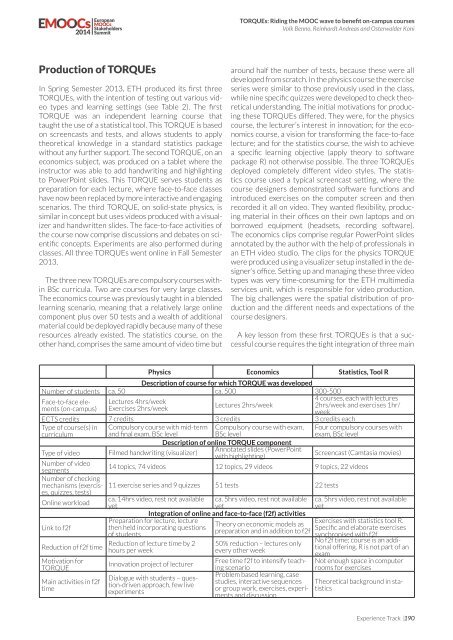zmWmQs
zmWmQs
zmWmQs
You also want an ePaper? Increase the reach of your titles
YUMPU automatically turns print PDFs into web optimized ePapers that Google loves.
TORQUEs: Riding the MOOC wave to benefit on-campus courses<br />
Volk Benno, Reinhardt Andreas and Osterwalder Koni<br />
Production of TORQUEs<br />
In Spring Semester 2013, ETH produced its first three<br />
TORQUEs, with the intention of testing out various video<br />
types and learning settings (see Table 2). The first<br />
TORQUE was an independent learning course that<br />
taught the use of a statistical tool. This TORQUE is based<br />
on screencasts and tests, and allows students to apply<br />
theoretical knowledge in a standard statistics package<br />
without any further support. The second TORQUE, on an<br />
economics subject, was produced on a tablet where the<br />
instructor was able to add handwriting and highlighting<br />
to PowerPoint slides. This TORQUE serves students as<br />
preparation for each lecture, where face-to-face classes<br />
have now been replaced by more interactive and engaging<br />
scenarios. The third TORQUE, on solid-state physics, is<br />
similar in concept but uses videos produced with a visualizer<br />
and handwritten slides. The face-to-face activities of<br />
the course now comprise discussions and debates on scientific<br />
concepts. Experiments are also performed during<br />
classes. All three TORQUEs went online in Fall Semester<br />
2013.<br />
The three new TORQUEs are compulsory courses within<br />
BSc curricula. Two are courses for very large classes.<br />
The economics course was previously taught in a blended<br />
learning scenario, meaning that a relatively large online<br />
component plus over 50 tests and a wealth of additional<br />
material could be deployed rapidly because many of these<br />
resources already existed. The statistics course, on the<br />
other hand, comprises the same amount of video time but<br />
around half the number of tests, because these were all<br />
developed from scratch. In the physics course the exercise<br />
series were similar to those previously used in the class,<br />
while nine specific quizzes were developed to check theoretical<br />
understanding. The initial motivations for producing<br />
these TORQUEs differed. They were, for the physics<br />
course, the lecturer’s interest in innovation; for the economics<br />
course, a vision for transforming the face-to-face<br />
lecture; and for the statistics course, the wish to achieve<br />
a specific learning objective (apply theory to software<br />
package R) not otherwise possible. The three TORQUEs<br />
deployed completely different video styles. The statistics<br />
course used a typical screencast setting, where the<br />
course designers demonstrated software functions and<br />
introduced exercises on the computer screen and then<br />
recorded it all on video. They wanted flexibility, producing<br />
material in their offices on their own laptops and on<br />
borrowed equipment (headsets, recording software).<br />
The economics clips comprise regular PowerPoint slides<br />
annotated by the author with the help of professionals in<br />
an ETH video studio. The clips for the physics TORQUE<br />
were produced using a visualizer setup installed in the designer’s<br />
office. Setting up and managing these three video<br />
types was very time-consuming for the ETH multimedia<br />
services unit, which is responsible for video production.<br />
The big challenges were the spatial distribution of production<br />
and the different needs and expectations of the<br />
course designers.<br />
A key lesson from these first TORQUEs is that a successful<br />
course requires the tight integration of three main<br />
Physics Economics Statistics, Tool R<br />
Description of course for which TORQUE was developed<br />
Number of students ca. 50 ca. 500 300-500<br />
Face-to-face elements<br />
(on-campus)<br />
Lectures 4hrs/week<br />
Exercises 2hrs/week<br />
Lectures 2hrs/week<br />
4 courses, each with lectures<br />
2hrs/week and exercises 1hr/<br />
week<br />
ECTS credits 7 credits 3 credits 3 credits each<br />
Type of course(s) in<br />
curriculum<br />
Compulsory course with mid-term<br />
and final exam, BSc level<br />
Compulsory course with exam,<br />
BSc level<br />
Description of online TORQUE component<br />
Type of video<br />
Filmed handwriting (visualizer)<br />
Annotated slides (PowerPoint<br />
with highlighting)<br />
Number of video<br />
segments<br />
Number of checking<br />
mechanisms (exercises,<br />
quizzes, tests)<br />
Online workload<br />
Link to f2f<br />
Reduction of f2f time<br />
Motivation for<br />
TORQUE<br />
Main activities in f2f<br />
time<br />
Four compulsory courses with<br />
exam, BSc level<br />
Screencast (Camtasia movies)<br />
14 topics, 74 videos 12 topics, 29 videos 9 topics, 22 videos<br />
11 exercise series and 9 quizzes 51 tests 22 tests<br />
ca. 14hrs video, rest not available ca. 5hrs video, rest not available<br />
yet<br />
yet<br />
Integration of online and face-to-face (f2f) activities<br />
Preparation for lecture, lecture<br />
then held incorporating questions<br />
Theory on economic models as<br />
of students<br />
preparation and in addition to f2f<br />
Reduction of lecture time by 2<br />
hours per week<br />
Innovation project of lecturer<br />
Dialogue with students – question-driven<br />
approach, few live<br />
experiments<br />
50% reduction – lectures only<br />
every other week<br />
Free time f2f to intensify teaching<br />
scenario<br />
Problem based learning, case<br />
studies, interactive sequences<br />
or group work, exercises, experiments<br />
and discussion<br />
ca. 5hrs video, rest not available<br />
yet<br />
Exercises with statistics tool R.<br />
Specific and elaborate exercises<br />
synchronised with f2f<br />
No f2f time; course is an additional<br />
offering. R is not part of an<br />
exam<br />
Not enough space in computer<br />
rooms for exercises<br />
Theoretical background in statistics<br />
Experience Track |190


